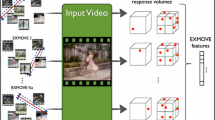Abstract
This paper presents a novel learning method for human action detection in video sequences. The detecting problem is not limited in controlled settings like stationary background or invariant illumination, but studied in real scenarios. Spatio-temporal volume analysis for actions is adopted to solve the problem. To develop effective representation while remaining resistant to background motions, only motion information is exploited to define suitable descriptors for action volumes. On the other hand, action models are learned by using boosting techniques to select discriminative features for efficient classification. This paper also shows how the proposed method enables learning efficient action detectors, and validates them on publicly available datasets.
Similar content being viewed by others
References
Dalal N., Triggs B.: Histograms of oriented gradients for human detection. Comput. Vis. Pattern Recognit. 2, 886–893 (2005)
Dalal N., Triggs B., Schmid C.: Human detection using oriented histograms of flow and appearance. Eur. Conf. Comput. Vis. 2, 428–441 (2006)
Dollár, P., Rabaud, V., Cottrell, G., Belongie, S.: Behavior recognition via sparse spatio-temporal features. In: VS-PETS, pp. 65–72 (2005)
Friedman J., Hastie T., Tibshirani R.: Additive logistic regression: A statistical view of boosting. Ann. Stat. 38(2), 337–374 (2000)
Gavrila D.M.: The visual analysis of human movement: A survey. Comput. Vis. Image Underst. 73(1), 82–98 (1999)
Gennert, M.A., Negahdaripour, S.: Relaxing the brightness constancy assumption in computing optical flow. A.I. Memo, p. 975. MIT Press, Cambridge (1987)
Horn B.K., Schunck B.G.: Determining optical flow. Artif. Intell. 17, 185–203 (1981)
Ke Y., Sukthankar R., Hebert M.: Efficient visual event detection using volumetric features. IEEE Int. Conf. Comput. Vis. 1, 166–173 (2005)
Kim, T.K., Wong, S.F., Cipolla, R.: Tensor canonical correlation analysis for action classification. In: CVPR (2007)
Laptev, I.: Improvements of object detection using boosted histograms. In: BMVC, vol. 3, pp. 949–958 (2006)
Laptev I., Lindeberg T.: Space-time interest points. IEEE Int. Conf. Comput. Vis. 1, 432–439 (2003)
Laptev, I., Pérez, P.: Retrieving actions in movies. IEEE Int. Conf. Comput. Vis., pp. 432–439 (2007)
Lienhart, R., Kuranov, A., Pisarevsky, V.: Empirical analysis of detection cascades of boosted classifiers for rapid object detection. MRL technical report (2002)
Niebles, J.C., Wang, H., Li, F.F.: Unsupervised learning of human action categories using spatial-temporal words. In: BMVC (2006)
Porikli F.: Integral histogram: A fast way to extract histograms in cartesian spaces. Comput. Vis. Pattern Recognit. 1, 829–836 (2005)
Proesmans, M., Gool, L.J.V., Pauwels, E.J., Oosterlinck, A.: Determination of optical flow and its discontinuities using non-linear diffusion. In: European Conference on Computer Vision, pp. 295–304. Springer, London (1994)
Ramanan, D., Forsyth, D.A.: Automatic annotation of everyday movements. In: Advances in Neural Information Processing Systems, vol. 16. MIT Press, Cambridge (2004)
Schuldt C., Laptev I., Caputo B.: Recognizing human actions: A local svm approach. Int. Conf. Pattern Recognit. 3, 32–36 (2004)
Shah M., Jain R.: Motion-Based Recognition. Computational Imaging and Vision Series. Kluwer, Dordrecht (1997)
Viola P., Jones M.: Rapid object detection using a boosted cascade of simple features. Comput. Vis. Pattern Recognit. 1, 511–518 (2001)
Wong, S.F., Kim, T.K., Cipolla, R.: Learning motion categories using both semantic and structural information. In: CVPR (2007)
Yilmaz A., Shah M.: Recognizing human actions in videos acquired by uncalibrated moving cameras. IEEE Int. Conf. Comput. Vis. 1, 150–157 (2005)
Author information
Authors and Affiliations
Corresponding author
Rights and permissions
About this article
Cite this article
Luo, Q., Kong, X., Zeng, G. et al. Human action detection via boosted local motion histograms. Machine Vision and Applications 21, 377–389 (2010). https://doi.org/10.1007/s00138-008-0168-5
Received:
Accepted:
Published:
Issue Date:
DOI: https://doi.org/10.1007/s00138-008-0168-5




